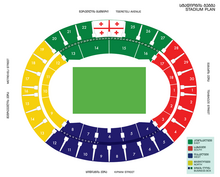Boris Paichadze Stadium
Background

On 29 September 1976, the first official match was played at the newly built stadium between Dinamo Tbilisi and Welsh Cardiff City. The game ended with a 3–0 victory for Dinamo.
The stadium hosted many glorious days during Dinamo's 1978 and 1979 triumphs. Holding lighted torches, 80,000 fans came in 1981 just to congratulate the 1980–81 European Cup Winners' Cup winning team Dinamo Tbilisi.
The Dinamo Arena is now one of the largest stadiums in Eastern Europe. Most of the seats in the second tier are covered by the roof. The USSR national football team played several international matches on the Dinamo Arena. Football clubs Spartak Moscow, Dynamo Kiev and Dynamo Moscow often played their autumn international matches at the stadium.
100,000 fans attended the opening game of the First Georgian Championship, match between FC Dinamo Tbilisi and FC Kolkheti-1913 Poti. The record attendance was in 1979, when 110,000 gathered to help Dinamo beat Liverpool F.C. 3:0 to go through to the European Champion Clubs' Cup quarter final, and in 1995, Georgia-Germany 0-2, UEFA EURO 1996 qualifaying match. In the Soviet Union, the stadium had the record for the highest average attendance (around 65,000 per game).
In 1995, the stadium was renamed Boris Paichadze National Stadium, after the former Georgian football player. The National Stadium has been the home ground of the Georgian National Football Team for several years. Georgia achieved memorable wins against Wales (5-0), and Poland (3-0).
The stadium was refurbished in 2006 and became an all-seater stadium. This reduced the capacity to 54,549.
On 11 August 2015, the stadium hosted UEFA Super Cup match between FC Barcelona and Sevilla FC.
History

The newly built "Dinamo" stadium, housing 23,000 spectators, was inaugurated in Tbilisi in 1936. The author of the project design was architect Archil Kurdiani (the elder).
It was under his leadership that in 1956 the stadium has been subject to reconstruction with the edition of steel structures, which has made it possible to increase its occupancy up to 36.000 spectators.
The reconstructed Dinamo Arena stadium was inaugurated on 26 September 1976. Architects Archil Kurdiani (the elder) and Gia Kurdiani, along with the construction designer Shalva Gazashvili extended the capacity of the stadium to 74,354.
Fragments of the 1936 Stadium were partly maintained, and yet quite complex architectural-designing construction elements were realized. The facility represented a console system supported by 58 pylons. Each of these pylons been supported by 24 poles, where the depth of each ranged from 8 to 12 meters. The console system comprised several elements. The evacuation terrace was arranging spectators ascending by 23 stairs between the II and I tiers. The II tier, like the evacuation terrace, represented an element of indivisible console system.
The solution for Roofing of II tier was also of the console design. 30 meter console-design roofing protects spectators against precipitations.
The Author’s approach for calculating and designing the Visual angle for II tier was original thus ensuring full visibility of the stadium for any spectator from any seat. The roof was also used as a cite for placement of lightning and insonification. The stadium was equipped by two electronic boards. At the level of evacuation terrace were arranged government boxes and commentary studios. The area below evacuation terrace and Ist tier tribunes housed floor sporting facilities, swimming pool, administrative unit and other administrative facilities arranged at floors from 1 to 2. The Stadium, along its entire perimeter was encircled by 2 communication tunnels. One at the ground level, while the other between the ground level and evacuation terrace. The stadium was fenced.
The former swimming pool of the stadium now houses the nightclub Bassiani.
See also
- Mikheil Meskhi Stadium
- List of football stadiums in Georgia
- List of rugby union stadiums by capacity
- Lists of stadiums
References
- ^ "Stadium".
- ^ "Boris Paichadze Dinamo Arena". Archived from the original on 2018-07-24. Retrieved 2013-04-16.
- ^ House, Arthur (21 September 2016). "Clubbers, forget London and Berlin – the place to dance is eastern Europe". The Guardian. Archived from the original on 12 February 2017. Retrieved 11 February 2017.
External links
- Dinamo Arena official website
- Dinamo Arena at FCDinamo.ge